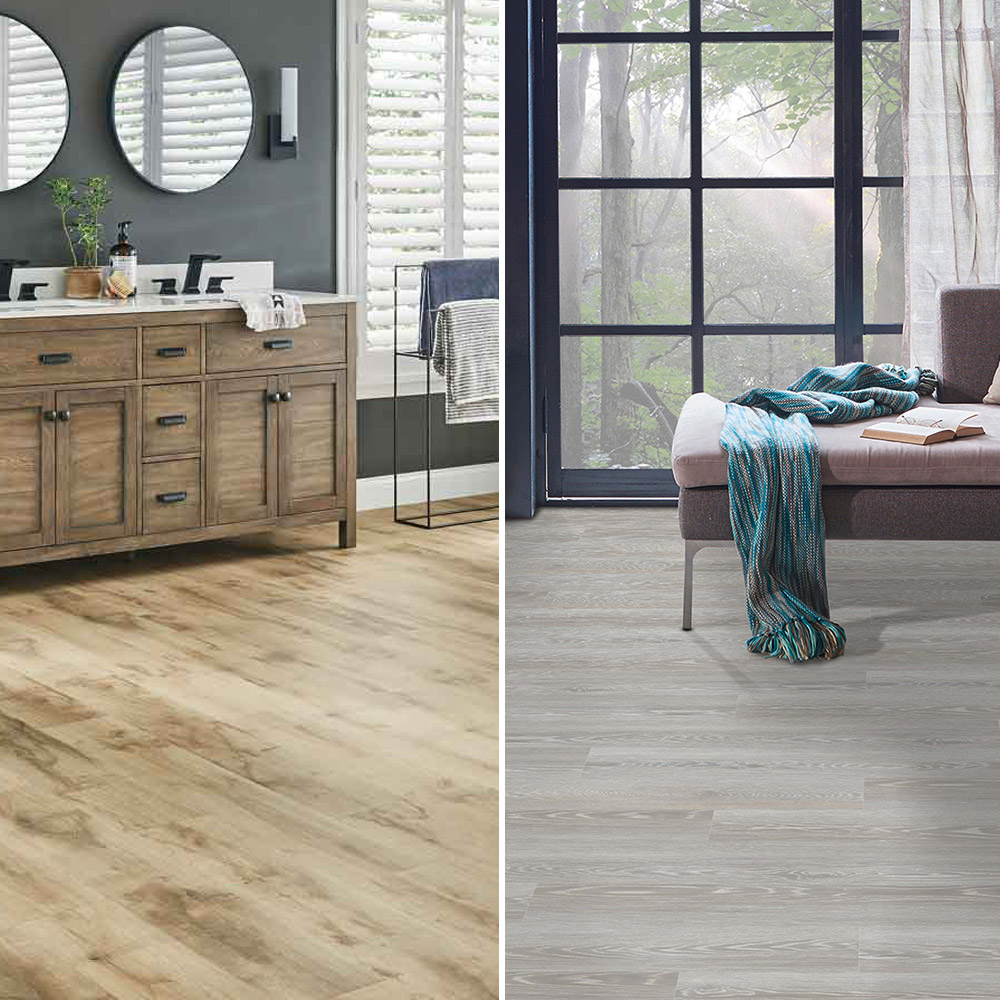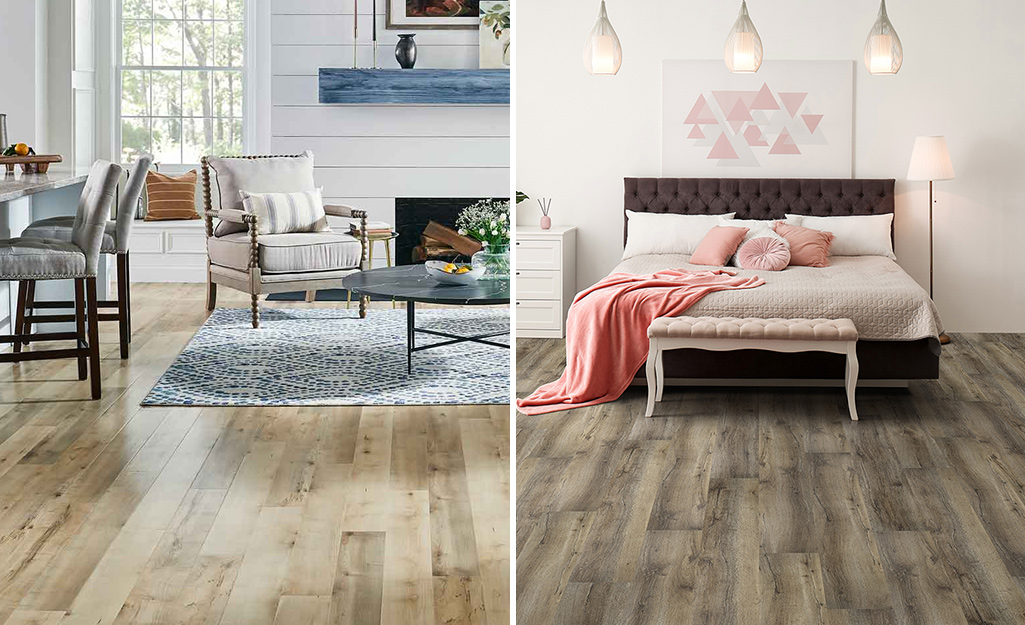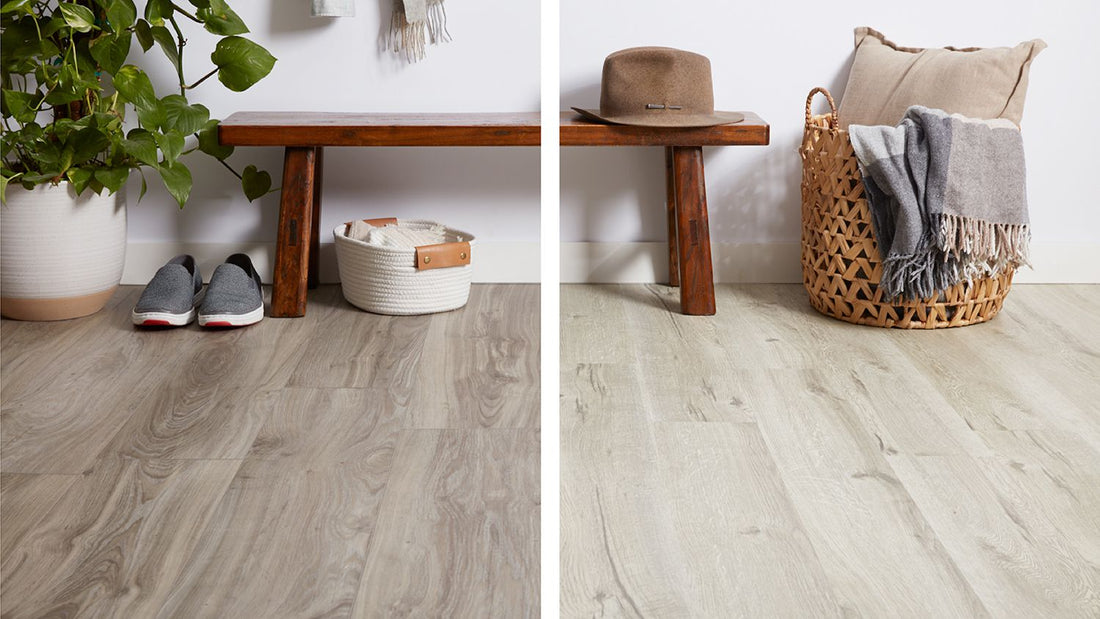This is a guest post from a fellow industry friend. Great discussion about laminate and vinyl floors. Enjoy!
Laminate flooring and vinyl flooring are both durable, cost-effective, and stylish flooring types. Additionally, they are easy to install and cost around the same. It is without a doubt that they are both beautiful flooring that are perfect for your home. It also appears that they are a bit identical when viewed from a distance. Are there any differences between the two? Yes, absolutely. The main differences between laminate flooring and vinyl flooring may affect the type of flooring you purchase and where it is installed.

Photo: The Home Depot
Every type of flooring is made from materials that determine how well it will withstand moisture. Laminate flooring and vinyl flooring share a number of similar characteristics: durability, good looks, economy, and ease of installation. Both types of flooring are equally good in all categories. Vinyl flooring is recommended for high-moisture areas since it is easy to keep clean. However, laminate flooring offers more style options and has a higher resale value.
How Do Laminate and Vinyl Flooring Differ?
Vinyl Flooring
Vinyl flooring is made of entirely synthetic materials. Vinyl tiles and sheets are usually made of fiberglass, which is covered with PVC and plasticizer. The sheet is embossed and printed with a surface print layer. This is covered with several wear layers and a no-wax polyurethane layer. Panel vinyl flooring is increasingly being sold with built-in subfloors.
The vinyl floor has a UV acrylic coating that protects it from UV rays. In addition, it has a wear layer that provides scratch resistance. Printed images or pictures represent the appearance of vinyl flooring. There is also a PVC layer that provides stability and support. This floor is primarily composed of a PVC core. Vinyl flooring has a soft layer of underlayment that is built into the subfloor to assist in balancing the uneven surface. Vinyl planks consist of a multilayer PVC vinyl core. A floating floor is made up of tiles or planks of luxury vinyl flooring that are connected side by side. The thickness of vinyl flooring ranges from 1.5mm to 6mm.
Laminate Flooring
Laminate flooring has a similar appearance and installation as vinyl flooring. Their main difference is that wood products are bound with resin at their core. The upper layer of the printed pattern is protected by a rigid, clear plastic wear layer. Planks of laminate flooring are available in a range of thicknesses ranging from 6mm to 15mm. The installation of a built-in underlayment, such as plank vinyl, is an option, but most laminate floors do not have underlayments attached. DIYers, however, can now find various laminate flooring types, some have pads attached which may eliminate the need for laying out a different underlayment. But because of proper installation guidelines (the need to protect against moisture from your subfloor) usually laminate comes without a pad attached so you can adjust for your project's needs.
The top layer wear coating contains a transparent aluminum oxide layer that protects the floor from scratches. Scratch resistance is one of laminate floorings' greatest strengths. In addition, it contains a printed layer that enhances the appearance of the flooring. Finely compressed wood fibers make up the core layer of the laminate floor. The built-in subfloor of the laminate flooring provides support for the unstable subfloor.
If you want to see more about laminate and vinyl flooring, watch this video:
How Do Laminate and Vinyl Flooring Look Like?
The appearance of laminate flooring is one of its most distinguishing features. There is a high-definition photographic layer under the transparent wear layer of all laminate floors to create the appearance of real wood or stone. In laminate flooring, you will find nearly every colour, species, and size of natural wood and stone flooring: wood that has been hand scraped, reclaimed wood, multi-tonal, natural finish, whitewashed, multi-length, and many more. There is an embossed, dense, realistic design on the upper layer of laminate flooring that depicts a realistic picture of the portrayed material, such as wood, ceramic, or stone.

Photo: The Home Depot
Vinyl flooring, especially luxury vinyl plank flooring, can look authentic. Since deeper embossing is possible, a thicker core vinyl floor appears more like hardwood. Vinyl flooring and laminate flooring are more likely to resemble hand-scraped wood, ceramics, stones, and other materials.
In high-quality vinyl flooring, there is an image or photo layer beneath the hard, clear wear layer. Typically, the image depicts a wood species (such as oak, maple, or hickory) or, less commonly, a stone. However, not all vinyl flooring has this realistic appearance. Older and cheaper sheet and tile vinyl flooring is printed using rotogravure (like a cylindrical printing press) and then overlaid with a clear wear layer.
Is Laminate and Vinyl Flooring Heat and Water Resistant?
Most laminate flooring has a HDF fiberboard core. Due to its wood composition, this layer will become soft and swell if it is exposed to water. Once the fiberboard layer has dried, it won't regain its previous size, so unless you pay a premium price for a special core board, the best practise is to avoid what being exposed to laminate flooring. Soggy cores can cause the wear and design layers to peel away, bottom line, don't get your laminate wet. It was ruin it. Laminate flooring that has been water-damaged needing to be replaced rather than repaired. Laminate flooring’s high-density fiberboard core is generally unaffected by heat. But other layers, such as the top wear layer, may melt under extreme heat. Like vinyl flooring, though, these temperatures far exceed those found in most homes.
Pooled water can be resisted for a limited period on well-fitted laminate flooring with firm seams and strong baseboards or moldings. Laminate flooring is not a good choice for family toilets or other locations where stagnant water is present. If you can commit to wiping up spills and drips as soon as possible, laminate flooring could be a good choice.
A vinyl floor is entirely waterproof from top to bottom as well as all edges. When vinyl flooring is soaked in water, it is possible to dry it out and it will retain its dimensions and appearance. Heat can affect vinyl flooring, just like any other plastic. The heat specifications that most vinyl floorings meet, however, are usually much higher (158 Fahrenheit) than what one can expect to endure on a daily basis. The materials used in vinyl tiles, luxury tiles, and sheet vinyl flooring are usually 100% water-resistant. In damp areas such as bathrooms and basements, vinyl flooring outperforms laminate flooring.
How Are Laminate and Vinyl Flooring Maintained?

It's best to start by cleaning vinyl floors and laminate floors with dry methods such as vacuuming, brushing, sweeping, or dust mopping. In most cases, damp mopping with a neutral detergent will remove embedded dirt.
Vinyl flooring differs from laminate flooring when it comes to wet mopping. If your floor is particularly dirty, wet mopping may be the most effective method of cleaning it. Wet mopping of vinyl flooring is possible, but it is not possible with laminate flooring. If you must clean laminate flooring with water, use a damp mop that is almost dry when you touch it. Vinyl flooring has the advantage of being easy to clean and maintain. Using appropriate cleaning agents, vinyl flooring that is in excellent condition can be wet-mopped.
How Durable Are Laminate and Vinyl Flooring?
The laminate flooring is durable and requires little maintenance. It is important to note, however, that some laminate flooring layers may wear away over time or if they are exposed to water for an extended period of time. Once the laminate's top wear layer has been damaged or cracked, it cannot be repaired. When delamination occurs, the top layers peel away, allowing liquid to penetrate the lower layers.
There are certain types of vinyl flooring that are prone to delamination. The water resistance of thin vinyl flooring planks is greater than that of thicker ones. Since the thin plank is composed of a cohesive sheet of polyvinyl chloride (PVC), it has a lower chance to delaminate. A self-adhesive vinyl tile, on other hand, may also detach over time. In general, vinyl flooring is a durable flooring material that can withstand considerable wear and tear. The benefits of vinyl flooring include its strength, durability, and low maintenance requirements. Many businesses use vinyl flooring for its durability and easy maintenance.
How Are Laminate and Vinyl Flooring Installed?

Photo: The Plan Collection
Laminate flooring is installed via a click-and-lock technique, in which the tongue of one board is angled into the grooves of an adjacent plank. The first plank is then folded down until it reaches the same level as the other plank. This process seals the seam by putting the boards firmly. Laminate boards are cut with a regular circular saw or table saw fitted with a fine-tooth blade, or a hand saw.
Easy installation is a benefit of vinyl flooring. There are two ways to lay it: glued to the subfloor or loosely laid. In glued vinyl flooring, tiles or planks are glued together using liquid adhesive or a self-stick adhesive backing. Vinyl flooring loosely laid is also known as floating flooring, because the planks are not attached to the subfloor. Vinyl planks are also installed using the click-and-lock method. Cutting vinyl flooring boards can also be done with a knife. The plank is scored first, then bent on itself and a second cut is made from the back. For DIYers, sheet vinyl can be a challenging material to install. There is a significant amount of bulk, weight, and difficulty in handling the material. Additionally, cutting intricate pieces from sheet vinyl can be challenging. Professional installers are usually the best choice when it comes to sheet vinyl.
What Is The Lifespan of Laminate and Vinyl Flooring?
Typically, laminate flooring lasts from 10 to 25 years, but this depends on how well it is maintained. Most luxury vinyl flooring is covered by a 20-year warranty. The lifespan of thick, quality vinyl flooring can be as long as 25 years, while the lifespan of thinner vinyl flooring is less than 10 years.
What Is The Environmental Impact of Laminate and Vinyl Flooring?
There are several laminate flooring companies that manufacture LEED MR4 (Recycled Content) certified products. There is, however, a plastic layer on the surface of laminate flooring, and the melamine resins that are used to make its core layer are not environmentally friendly since they may emit toxic fumes.
Over the past few years, vinyl flooring has gained increased recognition as a green product. Some vinyl flooring manufacturers now offer products that achieve LEED credit EQ4.3 for low-emitting materials. When burned, vinyl releases toxic chemicals. A vinyl product cannot decompose in landfills, and recycling is generally not an option.
It is worth noting that laminate flooring has a slight advantage if you are concerned about the environment due to the natural wood component of its fiberboard core. Nevertheless, neither of these products is as environmentally friendly as real hardwood, bamboo floors, or linoleum.
Does Laminate Flooring and Vinyl Flooring Feel Comfortable Underfoot?

Photo: Pinterest
It may not feel the same as wood, but laminate flooring can still have a pleasant warmth, particularly when paired with a good underlayment. The feel of vinyl flooring can feel a little cold or tight on the feet, especially if it is laid over cement or ceramic flooring. Laminate flooring becomes more comfortable to walk on when it is paired with either felt underlayment or foam underlayment.
It is generally accepted that vinyl and laminate flooring can be used interchangeably in residential applications. The most important factors that influence the decision are personal: Style options, textures, and price. The only exception to vinyl's interchangeability is water. There is no doubt that vinyl flooring is better suited for high-moisture environments than laminate flooring, making it a great choice for bathrooms. When it comes to whole-house installations, laminate flooring often makes sense because it has a wide range of options available. Compared to wood floors, laminate flooring can feel hollow underfoot.
Other flooring blog articles you may want to read:
Torlys Laminate Flooring Brand Details
German-Made Laminate Flooring Clearance
Best Buy Vinyl Flooring / Compton SPC Vinyl
COREtec Plus Luxury Vinyl Plank: A Vinyl Flooring Option with Form and Function
